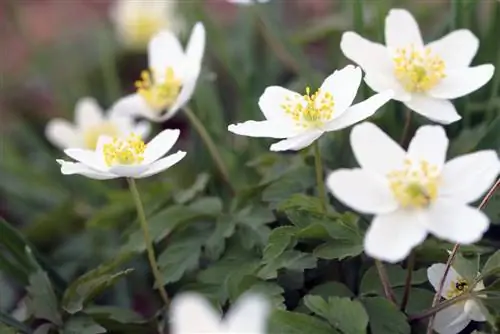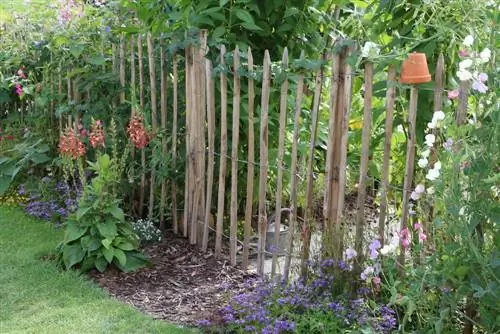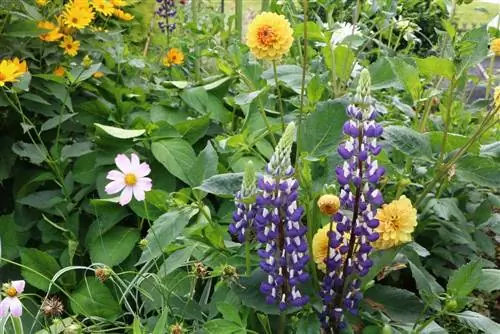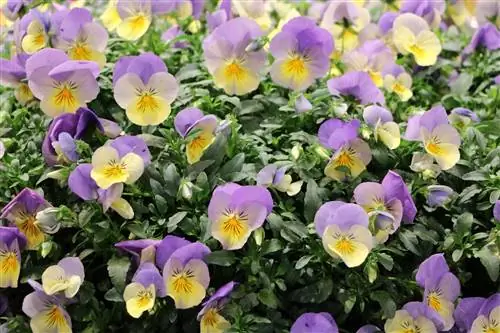- Author admin [email protected].
- Public 2023-12-17 03:39.
- Last modified 2025-06-01 06:48.
With its numerous flowers and completely natural growth, the autumn anemone is one of the particularly beautiful garden flowers. When summer comes to an end and many plants have bloomed, the autumn anemone appears with its beautiful variety of flowers. It has been delighting gardeners in our Central European region with ease since the 19th century. Since it feels very comfortable here, its care and growth is very easy. Sometimes it reaches an impressive height of up to two meters and can be seen from a distance.
Profile
- Height 15 - 30 cm
- Planting distance 10 - 15 cm
- Flowering in the first half of spring
- Humus-rich, well-drained soil
- Sunny to partially shaded location
- Root tubers available in autumn and winter
Soil and location for the autumn anemone
The autumn anemone loves humus-rich soil, which can also be loamy. In any case, the soil should be well-drained, as it cannot tolerate waterlogging or compaction of the soil. It develops splendidly in a sunny to partially shaded location. However, a place under a tree is very unfavorable as it cannot tolerate the drops that fall when it rains. Also known as the Japanese anemone, the delicate perennial plant is able to produce pretty flowers even in poor lighting conditions. It really brightens up the cooler autumn with its splendid colors. The longer it stands in one and the same location, the more comfortable it will feel there and adapt to the circumstances.
A splendor of color in the cottage garden
The variety of colors of the autumn anemone ranges from a clear white to various shades of pink to a warm carmine red. Their petals are simple or double. To immerse the garden in a variety of colors, it is recommended to combine early-blooming anemones with varieties that emerge late in the fall. Some varieties start flowering in July, while others only open their small leaves in September. In a colorfully designed cottage garden it is a feast for the eyes for many weeks. It is also one of the nectar plants that attract bees and butterflies.
Planting in autumn or spring
When planning the flower borders, give the pretty autumn anemone enough space to release into the wild in the next few years. It forms runners via its fine root system from which new, pretty plants develop. The perennial is usually planted in late summer or autumn. In the first year they need a little support during the cold winter. A little brushwood and leaves are enough to protect them from frost damage.
Alternatively, the autumn anemone can also be planted in spring. These plants often show that they are far more frost hardy in their first winter than perennials planted in the fall.
Simple and undemanding with little effort
Offer your autumn anemone moist soil without waterlogging. In addition, it needs a lot of nutrients, which good humus soil provides. It is therefore a good idea to provide the anemone with fresh compost after the flowering phase. However, if it is in a very sunny place, it will be happy to receive multiple doses of fresh rainwater and compost. It produces abundant flowers and develops excellently. Otherwise, the relatively undemanding plant does not need any further fertilizer.
The Pouring
As an undemanding plant, the autumn anemone doesn't like one thing at all: dryness. Therefore, the soil should be able to retain water to provide plants with sufficient moisture. With low plants that cover the ground well, an excellent climate can be created so that the autumn anemones do not hang their heads when it is dry. On the other hand, they definitely don't want to stand in the flowerbed with their feet “wet.” Here, as with many other crops, a good balance is required.
When winter approaches
Autumn anemones show their beauty especially when combined with other flowers. White anemones are an enrichment for pretty autumn plants in deep red or a beautiful blue. Combine as you wish and set up a natural flower bed that will delight you with new colors and flowers every month. After flowering, they are cut back in late autumn and then grow beautifully again the next year. Depending on the region, they are covered to protect them from the winter cold. However, the plants develop better winter hardiness from year to year, so only the young plants need winter protection.
Care tips
Various varieties of autumn anemones grow considerably tall. To prevent the delicate stems from bending, it is recommended to tie them to a stick. This is how they are protected.
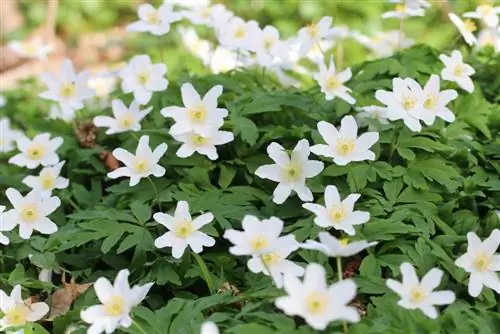
Anemones planted near a wall should always be watered adequately. A stone wall radiates a lot of heat. Therefore, check the condition of the soil when the sun is shining. After flowering, multiply your pretty favorites and create a new flower bed. To do this, simply dig up the branches of the autumn anemone and move them to their new location. The sensitive varieties should only be planted in spring. They grow better and have more time to gather strength for the winter phase. More robust varieties, on the other hand, can also be transplanted in autumn with good cover.
Popular species and varieties
Anemone blanda is native to the Near East, the Caucasus and southern Europe and remains quite low at 15 cm. If left uncut, it forms a large carpet of white, pink or blue flowers from late winter to early spring. It thrives particularly well in partial shade, such as under deciduous trees. If you like blue flowers, choose a variety like 'Atrocoerulea'. 'White Splendor' has white flowers. 'Charmer' blooms in pink, and if you prefer a bright red, the variety 'Radar' is recommended.
Anemone coronaria, the crown or garden anemone, is often seen in flower shops. It blooms red, blue, cream or purple. Commonly offered varieties include 'De Caen' and 'St. Brigid`.
Anemone x fulgens, a hybrid, has striking scarlet flowers and grows to a height of 20 - 30 cm.
Anemone nemorosa, the well-known wood anemone, was originally at home in the forests of Europe and East Asia. It therefore works best in a natural environment. With its three-part, 15 cm high leaf clusters, it is ideal as a ground cover. The flowers of the poisonous wood anemone are usually white with a pink tint. However, there are also lavender-colored forms, such as 'Robinsoniana', and those with white-filled flowers, such as 'Plena'.
Culture
Plant the root tubers 5 cm deep in humus-rich, well-drained soil in autumn. The plant spacing is 10 - 15 cm. A. coronaria and A. x fulgens thrive best in sunny locations. A blanda and A. nemorosa, on the other hand, prefer a partially shaded place in the garden.
With the exception of A. coronaria, all anemones with tuberous roots can be left in the ground for about 3-5 years. Dig up A. coronaria in the fall and store the plant during the winter months.
Propagation
When the foliage dies off in late summer, the root tubers are dug up and the rhizomes are divided.
Pests and diseases
Watch out for caterpillar infestations. Stems, leaves and flower buds are often eaten by pests. Some varieties such as 'De Caen' and 'St. Brigid` tend to rust.
Finally a good word
A naturally landscaped garden is wonderfully enriched with different varieties of autumn anemones. No matter how delicate the plant may seem in appearance, once the roots are firmly planted in the ground, it develops beautiful foliage with lots of beautiful, small flowers. Their advantages lie in their undemanding nature and the ability to reproduce naturally in the flowerbed.

